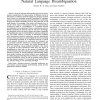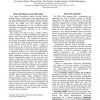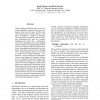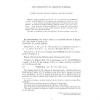770 search results - page 44 / 154 » Subsequence similarity language models |
TNN
1998
14 years 11 months ago
1998
Abstract—Natural language understanding involves the simultaneous consideration of a large number of different sources of information. Traditional methods employed in language an...
BPM
2010
Springer
15 years 29 days ago
2010
Springer
Abstract. A configurable process model describes a family of similar process models in a given domain. Such a model can be configured to obtain a specific process model that is sub...
AAAI
2000
15 years 1 months ago
2000
or cone, abstraction is chosen to represent a spectrum of user inputs/requirements that are narrowed, refined, and structured into a system design. User inputs require refinement f...
122
click to vote
EMNLP
2008
15 years 28 days ago
2008
While significant effort has been put into annotating linguistic resources for several languages, there are still many left that have only small amounts of such resources. This p...
ECCC
2008
14 years 12 months ago
2008
Higman essentially showed that if A is any language then SUBSEQ(A) is regular, where SUBSEQ(A) is the language of all subsequences of strings in A. Let s1, s2, s3, . . . be the sta...




